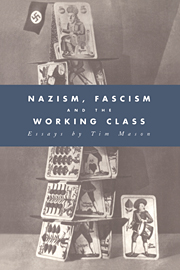Book contents
- Frontmatter
- Contents
- Acknowledgements
- List of abbreviations
- Introduction by Jane Caplan
- 1 Some origins of the Second World War
- 2 The primacy of politics. Politics and economics in National Socialist Germany
- 3 The origins of the Law on the Organization of National Labour of 20 January 1934. An investigation into the relationship between ‘archaic’ and ‘modern’ elements in recent German history
- 4 Internal crisis and war of aggression, 1938–1939
- 5 Women in Germany, 1925–1940. Family, welfare and work
- 6 Intention and explanation. A current controversy about the interpretation of National Socialism
- 7 The containment of the working class in Nazi Germany
- 8 The Turin strikes of March 1943
- 9 The domestic dynamics of Nazi conquests. A response to critics
- 10 Whatever happened to ‘fascism’?
- Bibliography of publications by Tim Mason
- Bibliography of works cited
- Index
8 - The Turin strikes of March 1943
Published online by Cambridge University Press: 06 January 2010
- Frontmatter
- Contents
- Acknowledgements
- List of abbreviations
- Introduction by Jane Caplan
- 1 Some origins of the Second World War
- 2 The primacy of politics. Politics and economics in National Socialist Germany
- 3 The origins of the Law on the Organization of National Labour of 20 January 1934. An investigation into the relationship between ‘archaic’ and ‘modern’ elements in recent German history
- 4 Internal crisis and war of aggression, 1938–1939
- 5 Women in Germany, 1925–1940. Family, welfare and work
- 6 Intention and explanation. A current controversy about the interpretation of National Socialism
- 7 The containment of the working class in Nazi Germany
- 8 The Turin strikes of March 1943
- 9 The domestic dynamics of Nazi conquests. A response to critics
- 10 Whatever happened to ‘fascism’?
- Bibliography of publications by Tim Mason
- Bibliography of works cited
- Index
Summary
in this chapter I shall try to answer three questions: what exactly happened on Friday 5 March and Saturday 6 March 1943 in the great factories of Turin; why the most detailed studies to date on the March strikes give such discrepant accounts of those two days; and why these two questions, which may seem both pedantic and insignificant, are actually of some importance. Since I can give a definite answer only to the last of them, I shall tackle them in reverse order, i.e. starting with the conceptual certainties (why they are so important), then passing into conjecture (why the discrepancies), and finally arriving at what we shall perhaps never know: what really happened.
The wave of strikes in March–April 1943 was the first time people subjected to a native fascist regime offered mass resistance. It was, moreover, a successful act, with the result that there was no great cost in human lives to the strikers. It was in every way the most important act of mass resistance, and not only because it was the first or because it succeeded: the German working class never, even subsequently, defied their Nazi masters in any way even remotely comparable to this. Yet it has been said that for over a decade the Italian working class had grown accustomed to ever-lower living standards and ever-new forms of humiliation and oppression, without having given birth to any sustained and durable protest movement.
- Type
- Chapter
- Information
- Nazism, Fascism and the Working Class , pp. 274 - 294Publisher: Cambridge University PressPrint publication year: 1995
- 1
- Cited by



